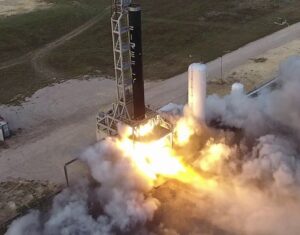Noosphere Ventures aims to build an integrated space powerhouse: Q&A with managing partner Max Polyakov
By Jason Rainbow

Ukrainian entrepreneur Max Polyakov, with his Silicon Valley-based investment vehicle Noosphere Ventures Partners, is on a mission to build out a vertically integrated space business.
A year after Noosphere founded satellite imagery venture Earth Observation Data Analytics (EOSDA) in 2016, Polyakov got into the launch business by snapping up Firefly Aerospace out of bankruptcy.
The Noosphere space portfolio that is public today includes electric propulsion systems maker SETS and orbital transfer vehicle provider D-Orbit.
However, small-satellite-focused Firefly Aerospace, which is nearing its first orbital attempt, is its flagship space investment. In January, Firefly Aerospace said it is looking for $350 million to accelerate development, as SPACs — special-purpose acquisition companies that offer businesses a fast route to public markets — attract a significant amount of investor attention in the space industry.

Meanwhile, EOSDA aims to launch its first synthetic aperture radar (SAR) satellites next year.
Linking different space businesses together helps Noosphere gain flight heritage for components under development. Products that are ready for the marketplace can be bundled together to lower costs for customers interested in integrated solutions.
SpaceNews caught up with Polyakov, Noosphere’s managing partner, about how this integrated approach is fairing during the COVID-19 pandemic, and how SPACs are changing the business environment.
How has the pandemic created opportunities for different kinds of partnerships or acquisitions with space companies that have perhaps come under distress?
The pandemic may have caused some companies to move more slowly and reassess their plans. However, I am more interested in the long-term health of my companies and our contribution to the space sector, and I am happy to report that we are moving ahead as expeditiously as possible.
Regardless of any short-term external challenges, we believe that we retain a significant advantage because of our thorough understanding of the market and deep expertise within our companies.
Has it helped or hindered your multi-sector, integrated investment strategy?
Obviously, the pandemic has had an impact on all industrial sectors, and space is no exception. However, COVID-19 has not affected our strategy. We are continuing to invest and innovate in each of our space companies and our long-term prospects remain very bright.
The principles of vertical integration hold firm, allowing a new generation of space companies to retain control over launch vehicles, communications, space earth observation, ground stations and data analysis. This will continue to give us significant advantages long after COVID-19 has been controlled.
Voyager and Redwire are other investors that seem to be following a similar integrated strategy to Noosphere. Are you seeing more competition for deals?
Noosphere was an early entrant in the sector. Right now, we are focused on ensuring that our existing investments continue to be successful, while always keeping an eye out for deals that may provide synergies for our businesses and advantages to our customers.
Firefly Aerospace was largely protected from COVID-19 supply issues because it is so vertically integrated. But it looks like the first launch is still delayed — what is the latest there?
Firefly plans to launch soon this year. First launches are typically delayed as teams continue to refine the details. Even though the world has been launching modern rockets for decades, spacecraft are highly complex vehicles. So we anticipated some delays. Our partners are doing their best to minimize any delays. We remain in a very good place.
The launch company recently said it is looking to raise $350 million to help it expand faster. How much of this need for growth equity is in response to all the SPAC activity we’re seeing, which is accelerating many early space companies?
Firefly is seeking to raise more capital to continue its growth. Its need for capital is unrelated to the SPAC activity. The democratization and commercialization of space attracts a lot of speculative money, which tends to have a short-term approach. Our strategy, on the contrary, is to build a company with a long-term future.
Given all the activity and changes in the capital markets right now, do you anticipate this investment coming from strategic companies — like large satellite prime contractors — venture capital, or somewhere else?
We are hearing from a variety of investors who are excited about what we are doing. However, we want to partner with those who will be passionate about the venture they join, who have a long-term approach, and who are willing to invest not just their money but also their knowledge and expertise.
How is the rise of SPACs changing the game for early-stage space companies? Is it a healthy trend for the industry?
We are not surprised that capital is flowing into the space industry and SPACs are just another investment vehicle. Every decade, a new trend brings new bubbles. Even Isaac Newton, one of the smartest people on Earth, got trapped with his investment in England’s hottest stock at that time — the South Sea Company. But, I am worried that this trend could have some negative effects on the space industry specifically.
It’s possible that some space companies will partner with SPACs that have high-quality C-level investors who can bring not just money, but expertise and passion to grow these companies post-merger. However, this is a best-case scenario, which in my opinion is very remote. The overall trend is not healthy for the industry as companies with no intrinsic value can easily try to compete with complex technologies and overpromise what they actually can deliver. That means we could see an overcrowded market of projects with no real products.
I strongly believe that, with the space industry, companies’ core business must be viable, and there must be delivered products before any company can realistically go public. For these companies, SPACs may present a good chance to accelerate their growth, so let’s hope they’re the ones who will win this competition.
Could Noosphere be interested in setting up its own SPAC?
I don’t think so.
Environmental, social and corporate governance (ESG) is becoming increasingly important for all companies, and the financial markets that support them. How could this growing importance boost companies like EOS Data Analytics?
Organizations need to be aware of the impact their operations have, for example, on the Earth’s surface, the natural environment and on local communities. They must have detailed plans to mitigate those impacts. And, crucially, they must be able to communicate progress to a wide variety of stakeholders.
This creates tremendous opportunities for companies like EOS Data Analytics, which offers a superior solution here. Our satellites will have an impressive 2-3 day target revisit time for all locations on Earth. Combined with our modern data processing and compression algorithms, this will bring enormous benefits to a wide range of customers that need to monitor the physical impact of their operations. Furthermore, with the advanced cameras that we are developing and will employ, we are able to reduce the number of satellites required and this will enable us to make our pricing even more attractive.
We expect that EOSDA and companies like it will increasingly become an important part of the global economy as they provide significant benefits for both modern businesses and humankind overall.
Is ESG another one of those trends that are helping to branch space out to companies that have not traditionally been a part of the sector?
ESG is much more than a trend; I believe it is a permanent feature required of companies by concerned stakeholders. The Noosphere Ventures principles are rooted in the noosphere philosophy — first introduced by Volodymyr Vernandsky — in which knowledge is the driving force behind every further positive development on Earth.
I agree that it is bringing the space industry closer to new industrial sectors. In our case, because we can offer analytics of superior quality at much reduced prices — I am confident that our services are accessible to so many more end users that previously would not have engaged with the space industry.
You have spoken of a multi-decade plan for EOSDA that brings together launch vehicles, satellites, sensors, ground segments and data analytics. Does the SPAC trend accelerate that vision/plan?
EOSDA is the foundation of the entire vertically integrated ecosystem we are developing. It is the point of integration for all the firms that we have and for other market players. The strategy is to build a project that will accumulate all data and knowledge we receive from space and Earth and to make sure it is used to preserve the nature and environment on Earth. The EOSDA’s mission is not to raise fast money but to prolong our safe existence on the planet.
Is there anything you would like to add?
I am a strong believer that investing in world-class entrepreneurial teams, breakthrough technologies, transformative business models, and strong intellectual property can change the world — and I am convinced that we’re doing just that.
As a result, space is becoming more and more accessible to a vast range of industries due to its expanding applications and accessible pricing. Firefly’s contracts with NASA, for example, are extremely exciting, and I am honored by the responsibility that we have been given to deliver a suite of 10 science investigations and technology demonstrations to the Moon in 2023. I am equally excited by the possibilities that our vertically integrated system can bring to a vast range of customers in agricultural analytics, climate change monitoring, disaster management, oil and gas, forestry, green energy and real estate.
Exploring space is truly a great adventure — and now is perhaps the most exciting time for that. But, it is also important to understand why we do that and the answer is clear — for the benefit of humankind.
This Q&A has been edited for clarity
April 21, 2021 at 06:24AM
via SpaceNews read more...

Post a Comment